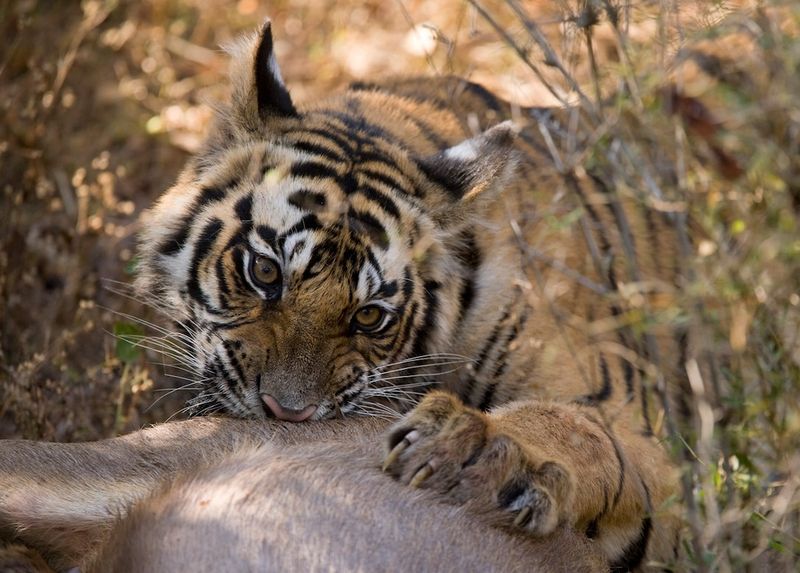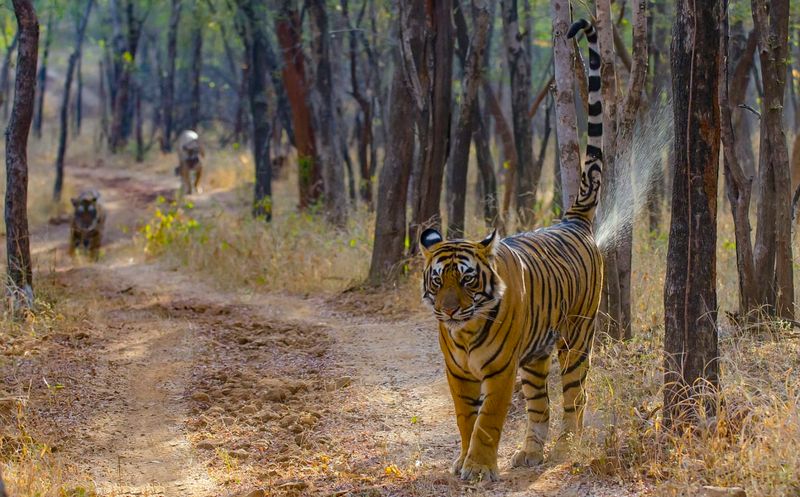16 Intriguing Tiger Facts Every Big Cat Enthusiast Should Know

Majestic striped hunters prowl through dense jungles with power and grace unlike any other big cat. Tigers captivate our imagination with their striking orange coats and fearsome reputation, yet they face unprecedented threats to their survival.
Whether you’re a wildlife enthusiast or simply curious about these magnificent creatures, these fascinating tiger facts will deepen your appreciation for nature’s perfect predator.
1. No Two Tigers Share The Same Stripe Pattern

Just like human fingerprints, every tiger’s stripe pattern is completely unique. Scientists use these distinctive markings to identify individual tigers in the wild.
This natural identification system helps researchers track populations without invasive tagging methods. Next time you see tigers, try comparing their stripes!
2. Tigers Can Leap Over 20 Feet In A Single Bound

Gravity seems optional when these big cats launch themselves through the air. Their powerful hind legs can propel them forward distances greater than a small bedroom.
Such impressive jumping ability helps tigers catch prey attempting to escape. Their muscles store energy like coiled springs before releasing in explosive bursts of speed.
3. White Tigers Aren’t A Separate Species

Contrary to popular belief, white tigers aren’t albinos or a distinct species. Their unusual coloration comes from a rare genetic mutation that affects pigmentation.
These stunning cats are primarily Bengal tigers with a recessive gene. In the wild, this coloration is extremely rare because it makes hunting difficult without protective camouflage.
4. A Tiger’s Roar Can Be Heard From Two Miles Away

Forget about loudspeakers – tigers have natural volume that puts technology to shame. Their earth-shaking roars travel across forests and grasslands to announce territory.
Special vocal cords allow these thunderous sounds to carry incredible distances. Low-frequency components of tiger roars can even pass through solid objects, making them truly feel the sound in their bones.
5. Tigers Have Night Vision Six Times Better Than Humans

Darkness poses no challenge for these nocturnal hunters. Their specialized retinas contain an abundance of rod cells that excel at collecting available light.
A reflective layer behind their retinas called the tapetum lucidum bounces light back through the eye for a second chance at detection. This adaptation gives tigers their distinctive eyeshine when caught in headlights or flashlights.
6. Tiger Saliva Has Antiseptic Properties

When tigers lick their wounds, they’re actually applying nature’s medicine. Their saliva contains compounds that help prevent infection and promote healing.
This natural antiseptic allows them to recover from injuries in the wild without modern veterinary care. Tigers spend hours grooming themselves daily, keeping their coats clean and wounds sanitized.
7. The Siberian Tiger Is The Largest Big Cat Species

Imagine meeting a cat that weighs as much as a small car! Siberian tigers can reach over 660 pounds and stretch more than 10 feet from nose to tail.
These northern giants evolved their impressive size partly due to Bergmann’s rule – animals in colder climates tend to be larger to conserve heat. Their massive paws act like natural snowshoes in deep winter snow.
8. Tigers Are Excellent Swimmers Who Enjoy Water

Unlike most cats who avoid getting wet, tigers plunge into rivers and lakes with enthusiasm. They can swim for miles and even chase prey through water.
Swimming helps tigers cool off in hot climates and access food sources other predators can’t reach. Some tigers in the Sundarbans mangrove forests have even developed a reputation for swimming between islands.
9. Tigers Have Memory Better Than Chimpanzees

Remarkable recall abilities make tigers nature’s memory champions. Studies show they remember locations, individuals, and events for years – even outperforming primates in certain tests.
This exceptional memory helps them navigate vast territories and remember successful hunting grounds. Female tigers teach their cubs using this cognitive advantage, passing down knowledge through generations.
10. Cubs Are Born Blind And Completely Helpless

Future apex predators start life incredibly vulnerable. Newborn tiger cubs weigh just 2-3 pounds, with sealed eyes that don’t open for about ten days.
Mother tigers hide their cubs in dense vegetation or caves while hunting. Cubs develop rapidly, beginning to follow their mother at six weeks and learning hunting skills by six months of age.
11. A Tiger’s Tongue Can Lick Meat Off Bones

Feeling a tiger’s tongue would be like sandpaper on steroids. Their tongues feature backward-facing barbs called papillae that function like natural meat hooks.
These specialized structures help tigers efficiently clean flesh from bones and groom their thick fur. The rough texture also aids in removing parasites and loose hair during grooming sessions.
12. Tigers Can Consume 88 Pounds Of Meat In One Sitting

Feasting champions of the animal kingdom, tigers can devour nearly a hundred pounds of meat in a single meal. This impressive capacity helps them survive when successful hunts might be days or weeks apart.
After gorging, tigers often sleep for days while digesting. They typically need to catch a large prey animal only once a week to sustain themselves.
13. Only 3,726 Wild Tigers Remain Worldwide

From over 100,000 a century ago, wild tiger populations have plummeted to alarming lows. Habitat loss, poaching, and human conflict have driven these magnificent cats to the brink.
Conservation efforts have shown promising results in some regions. Nepal doubled its tiger population between 2010 and 2022, proving recovery is possible with dedicated protection measures.
14. Tigers Use Scent Marking To Create Invisible Boundaries

Forget fence posts – tigers mark territory with aromatic calling cards. By spraying urine, leaving claw marks, and rubbing scent glands on trees, they create complex olfactory maps.
These scent markers contain chemical information about the tiger’s size, gender, and reproductive status. Other tigers can read these signals like we read street signs, helping avoid dangerous territorial conflicts.
15. Female Tigers Raise Cubs Alone For Two Years

Single motherhood is the norm in tiger society. After mating, male tigers play no role in raising offspring, leaving females to hunt, protect, and teach cubs all survival skills.
This demanding period lasts about two years until cubs become independent. Mother tigers show incredible dedication, sometimes going hungry to ensure their cubs eat first after a successful hunt.
16. The South China Tiger May Already Be Extinct In The Wild

Once roaming across southern China, this tiger subspecies hasn’t been reliably spotted in the wild since the 1980s. Intensive hunting campaigns and habitat destruction pushed them to the edge.
A few hundred South China tigers exist only in captivity today. Conservation breeding programs aim to someday reintroduce these tigers to protected wild areas, though success remains uncertain.






